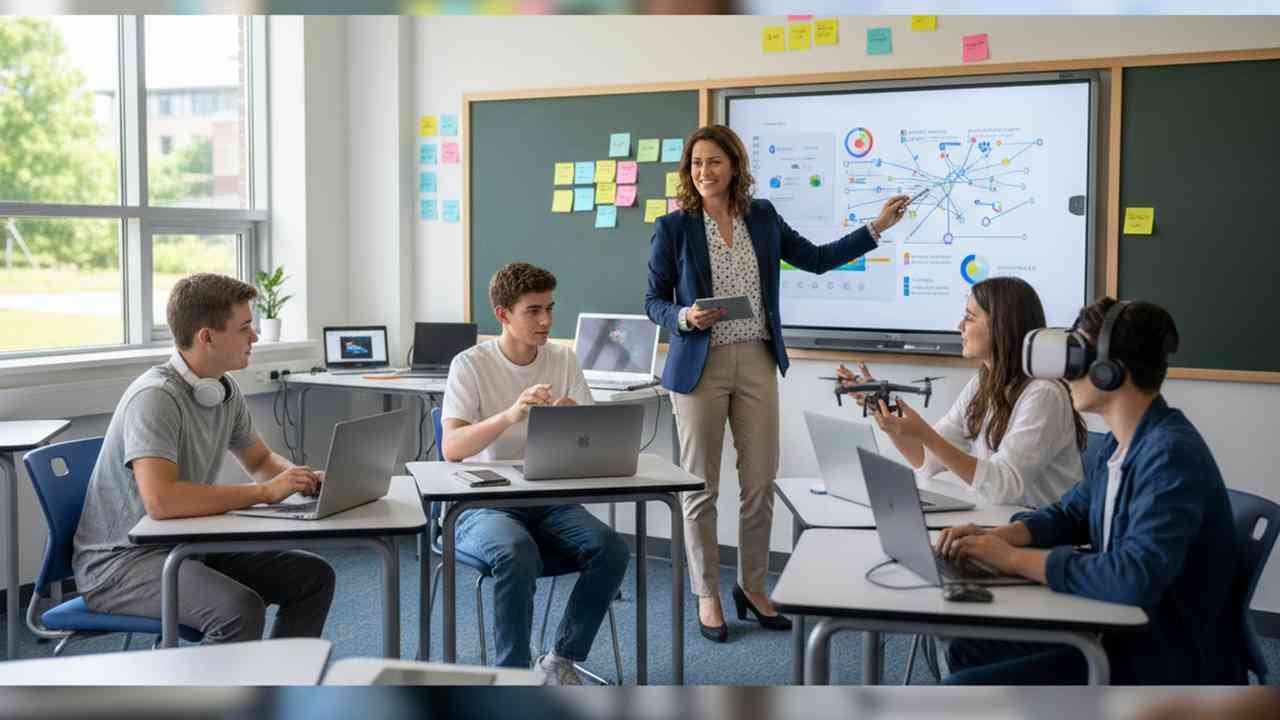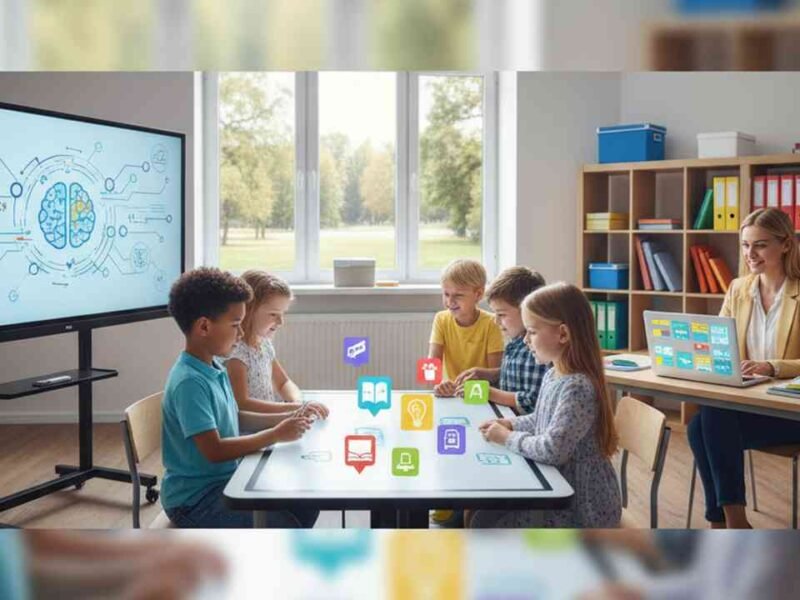Why Integrating Technology in Education is No Longer Optional
Imagine walking into a classroom buzzing with vibrant energy, where students’ eyes light up as they engage with interactive simulations, immersive VR experiences, and adaptive learning platforms. The world is moving faster than ever, and the integration of technology in education is no longer a luxury; it is an urgent necessity. Schools that lag behind risk leaving students unprepared for the competitive, digitally-driven world outside. Incorporating technology as a teaching resource ensures that learners not only grasp concepts faster but retain them longer, fostering a deep, intuitive understanding of complex subjects. Teachers equipped with cutting-edge tools can cater to diverse learning styles, offering tailored experiences that ignite curiosity and engagement. According to the International Society for Technology in Education (ISTE), classrooms that effectively integrate technology see a 34% increase in student engagement and a 27% improvement in knowledge retention. For educators striving to meet rigorous gifted education standards, embracing these tools is crucial. Every moment without technology is a missed opportunity to elevate learning outcomes and cultivate the innovative thinkers of tomorrow.
Understanding the Connection Between Technology and Gifted Education Standards
Meeting gifted education standards requires a nuanced understanding of both curriculum demands and student potential. Technology acts as a bridge, connecting abstract concepts with tangible, hands-on experiences that challenge gifted learners beyond the conventional classroom. For example, a physics student experimenting with virtual labs can witness real-time simulations of particle collisions, a sensory-rich experience impossible through textbooks alone. Such immersive learning tools not only deepen comprehension but provide measurable evidence of progress, aligning with educational benchmarks that demand rigor, creativity, and analytical prowess. Industry reports from EdTech Digest highlight that schools implementing technology with a focus on gifted education see a 41% improvement in critical thinking assessments. Every interactive whiteboard, learning app, or AI tutor becomes a tool to elevate standards, ensuring that no gifted mind is left unchallenged. The fear of falling behind in an era of rapid technological advancement is palpable, and educators who delay integration risk depriving students of opportunities to exceed expectations and achieve extraordinary outcomes.
Creating a Seamless Technology-Enhanced Curriculum
Designing a curriculum that seamlessly incorporates technology requires thoughtful planning and a keen eye for detail. Teachers must envision learning journeys where digital tools complement traditional instruction rather than replace it, weaving together lectures, discussions, and interactive activities into a cohesive tapestry. Imagine a history class where students explore ancient civilizations through augmented reality, walking through reconstructed streets of Rome or navigating the pyramids of Giza with a tactile sense of presence. This approach transforms abstract dates and facts into vibrant experiences, making content unforgettable. The key lies in aligning technology with gifted education standards, ensuring that each tool challenges higher-order thinking skills such as analysis, evaluation, and synthesis. By designing technology-enhanced lesson plans, educators can track progress through data analytics, adjust learning pathways in real time, and provide personalized feedback that nurtures every gifted mind. Delaying this integration leaves classrooms stagnant and students disengaged, creating a widening gap between traditional learning and the dynamic demands of today’s knowledge economy.
Leveraging Real-World Data and Verified Resources
Incorporating technology is not just about flashy apps or trendy platforms; it requires access to verified, reliable data that supports learning objectives and aligns with gifted education standards. Imagine students exploring climate change through real-time environmental data collected from sensors worldwide, visualizing complex datasets in dynamic, interactive graphs. Trusted sources like NASA, the World Health Organization, and peer-reviewed journals provide data that is both credible and engaging, transforming abstract theories into actionable insights. Real-world examples help gifted learners see the tangible impact of their studies, fostering a sense of urgency and relevance. Furthermore, integrating licensed software and verified educational platforms ensures data security, compliance, and reliability, building trust among educators and parents alike. Schools that ignore these standards risk exposing students to inaccurate or unverified information, undermining both academic integrity and student confidence. The urgency to adopt verified, data-driven technology is immediate – every classroom delayed is a missed opportunity for authentic, standards-aligned learning experiences.
Enhancing Engagement Through Immersive Learning Technologies
Engagement is the lifeblood of effective education, and immersive technologies provide a gateway to unprecedented levels of student involvement. Picture learners donning VR headsets to explore the human circulatory system from within, navigating arteries and veins as if on a microscopic journey. These experiences are not just visually stunning; they stimulate multiple senses, enhancing memory retention and comprehension. Integrating such technologies directly supports gifted education standards by fostering higher-order thinking, problem-solving, and creativity. Gamified learning platforms further amplify engagement, offering instant feedback, rewards, and adaptive challenges that keep students striving for excellence. Industry research from the Education Technology Research and Development journal confirms that immersive learning experiences improve student motivation by over 50%, creating an environment where curiosity thrives. Educators who hesitate to adopt these tools risk missing out on a transformative educational shift, leaving students disengaged and unprepared for the high-tech demands of modern academia and professional life.
Maximizing Teacher Efficiency and Professional Development
Integrating technology effectively requires educators to evolve alongside their tools. Professional development programs focused on digital literacy, instructional design, and adaptive learning strategies are critical for aligning classroom practices with gifted education standards. Consider a teacher utilizing AI-driven assessment tools to instantly identify gaps in student understanding, allowing them to provide targeted interventions within minutes rather than days. This level of responsiveness frees teachers to focus on mentorship, creativity, and advanced instruction, enhancing overall classroom productivity. Case studies from leading EdTech institutions show that educators who receive comprehensive technology training report a 37% increase in instructional efficiency and a 29% improvement in student outcomes. The urgency to invest in teacher training is now – schools that delay risk creating a generation of students supported by outdated methods while their peers thrive in digitally enriched environments. Every professional development opportunity missed is a chance lost to elevate teaching standards and empower gifted learners to reach their full potential.
Addressing Security, Licensing, and Compliance Concerns
Technology adoption in education is not without its challenges, and issues such as licensing, data security, and regulatory compliance must be addressed proactively. Trusted platforms with verified payouts, secure cloud storage, and responsive customer service ensure that students and educators can focus on learning rather than worrying about breaches or disruptions. For instance, licensed software like educational simulation suites guarantees legal compliance while providing robust, fully supported learning experiences. Gifted learners benefit from environments where technology is reliable, safe, and fully functional, allowing them to explore complex concepts without interruption. Compliance with gifted education standards also necessitates rigorous documentation and transparent evaluation metrics, ensuring every digital intervention is measurable and accountable. Schools that delay establishing secure, licensed systems risk legal complications, loss of trust, and a diminished learning experience. The urgency to implement compliant, secure technology solutions is immediate; every day without these protections exposes students and institutions to unnecessary risks.
Measuring Impact and Continuous Improvement
Integrating technology as a teaching resource is only effective if its impact is continuously measured and optimized. Real-time analytics, student performance dashboards, and adaptive learning algorithms provide educators with actionable insights to refine instructional strategies and align outcomes with gifted education standards. Imagine a classroom where AI identifies struggling students, automatically adjusting content difficulty, recommending enrichment modules, and tracking progress through sophisticated visualization tools. This creates a feedback loop that maximizes learning efficiency, ensures high engagement, and supports differentiated instruction tailored to gifted learners. Research by the EdTech Review shows that classrooms leveraging continuous assessment technologies see a 42% improvement in overall academic performance. Delaying the adoption of data-driven improvement practices risks stagnation, leaving teachers and students in a reactive rather than proactive educational environment. The pressure to implement these systems is immediate; the future of effective, standards-aligned education depends on it.
Fostering Collaboration and Global Learning Opportunities
Technology opens doors to collaboration and global learning opportunities that were unimaginable just a decade ago. Gifted students can now connect with peers worldwide, participate in joint research projects, or engage in international virtual classrooms, exposing them to diverse perspectives and challenging problem-solving scenarios. Platforms that facilitate secure, interactive collaboration enable learners to tackle real-world issues alongside experts and mentors, amplifying their skills and creativity. Integrating these tools aligns with gifted education standards by promoting intellectual risk-taking, leadership, and innovation. According to UNESCO, students involved in international collaborative projects demonstrate a 33% increase in critical thinking and cross-cultural competence. Schools that fail to leverage these opportunities risk isolating gifted learners, depriving them of experiences that cultivate empathy, resilience, and a global mindset. The urgency to implement collaborative technologies is tangible – every day without connection is a lost chance to empower students to thrive in an interconnected, digitally advanced world.
Taking Immediate Action: Transform Your Classroom Today
The time to act is now. Every moment spent hesitating to integrate technology into your curriculum is a moment students are missing transformative learning experiences. By embracing verified, licensed tools, investing in professional development, and aligning with gifted education standards, educators can unlock unprecedented levels of engagement, comprehension, and creativity. Imagine your students immersed in interactive simulations, real-time analytics guiding their learning, and global collaboration expanding their horizons – all happening in your classroom tomorrow. Don’t wait for the future; create it today. Start by exploring cutting-edge educational platforms at EdTech Digest, secure your licensing, train your team, and witness immediate transformation. The fear of missing out is real, and every second without action risks leaving your students behind. Empower your classroom with technology now, and become a trailblazer in the movement toward innovative, standards-aligned education.


